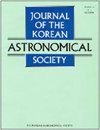TIME-SERIES PHOTOMETRY OF VARIABLE STARS IN THE GLOBULAR CLUSTER NGC 288
IF 0.8
4区 物理与天体物理
Q3 ASTRONOMY & ASTROPHYSICS
引用次数: 4
Abstract
We present the results of BV time-series photometry of the globular cluster NGC 288. Ob-servations were carried out to search for variable stars using the Korea Microlensing Telescope Network (KMTNet) 1.6-m telescopes and a 4k pre-science CCD camera during a test observation from August to December, 2014. We found a new SX Phe star and confirmed twelve previously known variable stars in NGC 288. For the semi-regular variable star V1, we newly determined a period of 37.3 days from light curves spanning 137 days. The light-curve solution of the eclipsing binary V10 indicates that the system is probably a detached system. The pulsation properties of nine SX Phe stars were examined by applying multiple frequency analysis to their light curves. We derived a new Period-Luminosity (P-L) relation, = −2.476(±0.300) logP −0.354(±0.385), from six SX Phe stars showing the fundamental mode. Additionally, the period ratios of three SX Phe stars that probably have a double-radial mode were investigated; P FO /P F = 0.779 for V5, P TO /P FO = 0.685 for V9, P SO /P FO = 0.811 for V11. This paper is the first contribution in a series assessing the detections and properties of variable stars in six southern globular clusters with the KMTNet system.球状星团NGC 288中变星的时间序列光度测定
本文介绍了球状星团ngc288的BV时间序列光度测定结果。2014年8月至12月,利用韩国微透镜望远镜网络(KMTNet)的1.6 m望远镜和一台4k预科级CCD相机对变星进行了观测。我们在NGC 288中发现了一颗新的SX Phe星,并确认了12颗以前已知的变星。对于半规则变星V1,我们从137天的光曲线中新确定了37.3天的周期。食双星V10的光曲线解表明该系统可能是一个分离的系统。采用多频分析方法对9颗SX Phe星的光曲线进行了脉动特性研究。我们从六颗显示基本模态的SX Phe恒星中推导出新的周期-光度(P-L)关系=−2.476(±0.300)logP−0.354(±0.385)。此外,我们还研究了三颗可能具有双径向模式的SX Phe恒星的周期比;V5的P FO /P F = 0.779, V9的P TO /P FO = 0.685, V11的P SO /P FO = 0.811。本文是一系列利用KMTNet系统评估南方六个球状星团中变星的探测和特性的第一篇论文。
本文章由计算机程序翻译,如有差异,请以英文原文为准。
求助全文
约1分钟内获得全文
求助全文
来源期刊

Journal of the Korean Astronomical Society
地学天文-天文与天体物理
CiteScore
1.30
自引率
10.00%
发文量
0
审稿时长
>12 weeks
期刊介绍:
JKAS is an international scientific journal publishing papers in all fields of astronomy and astrophysics. All manuscripts are subject to the scrutiny of referees. Manuscripts submitted to JKAS must comply with the ethics policy of JKAS. Six regular issues are published each year on February 28, April 30, June 30, August 31, October 31, and December 31. One year''s issues compose one volume.
 求助内容:
求助内容: 应助结果提醒方式:
应助结果提醒方式:


